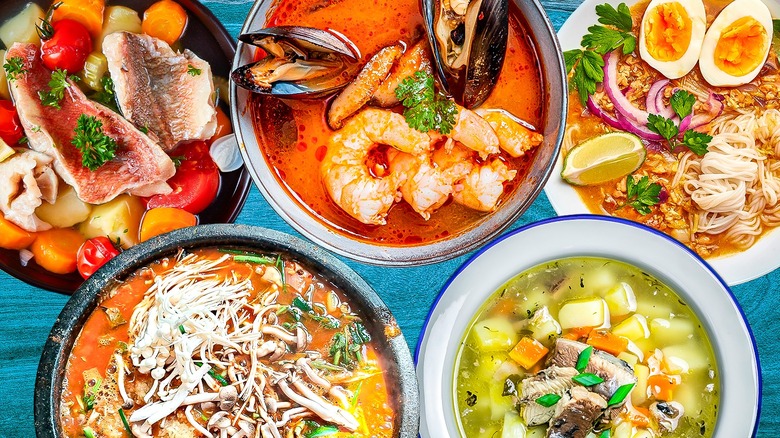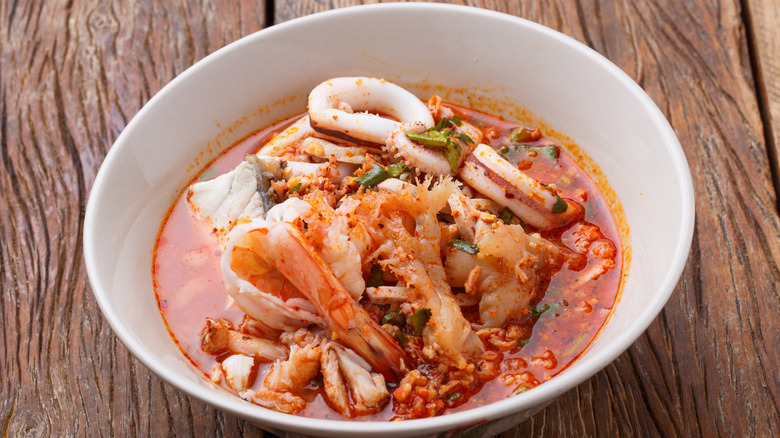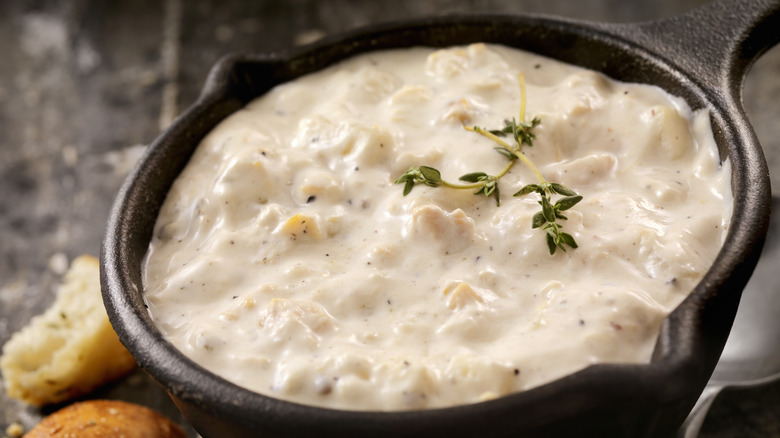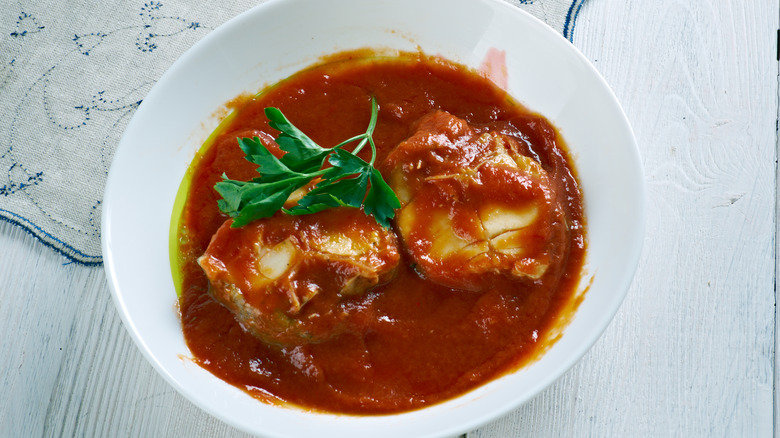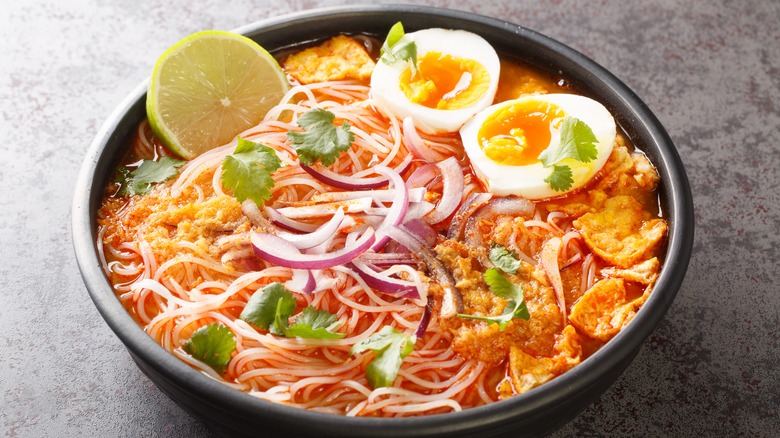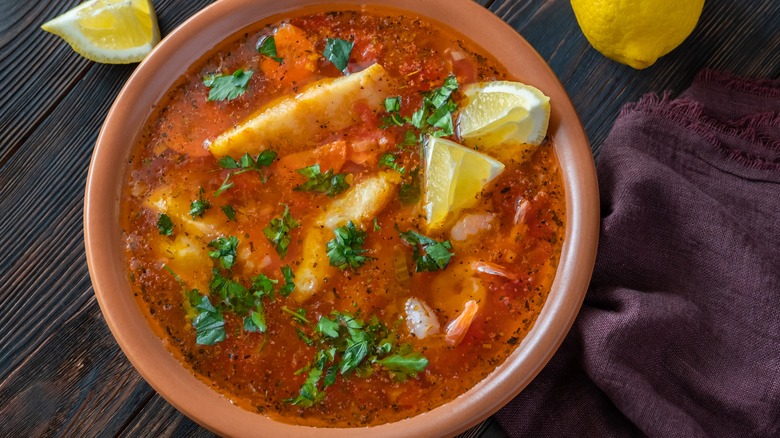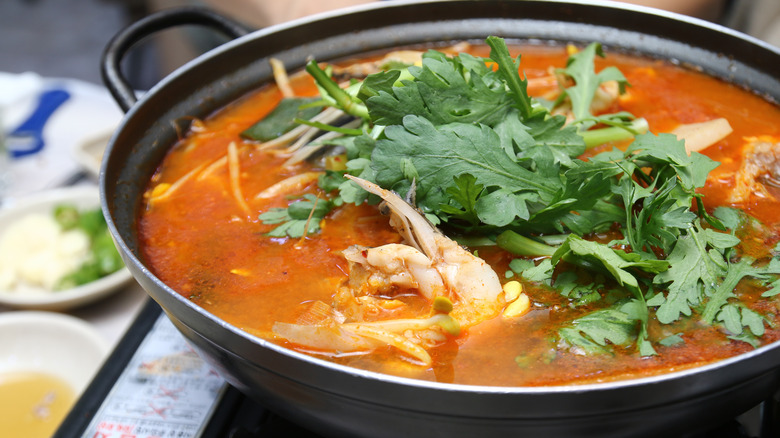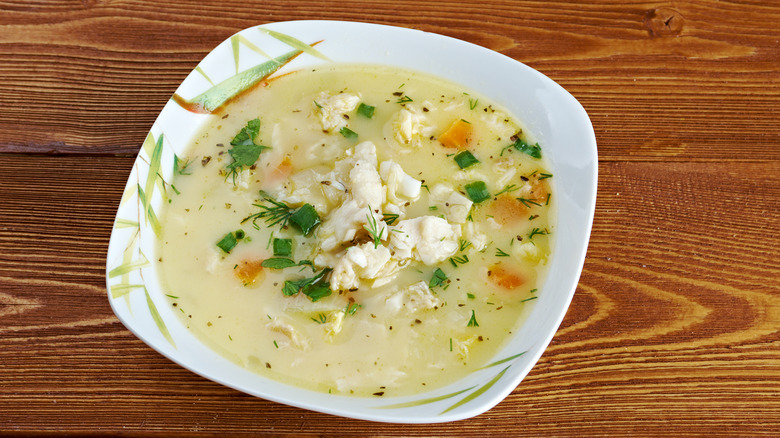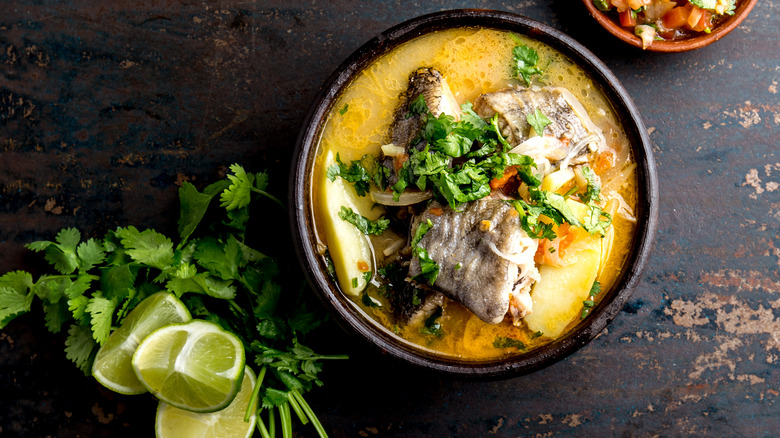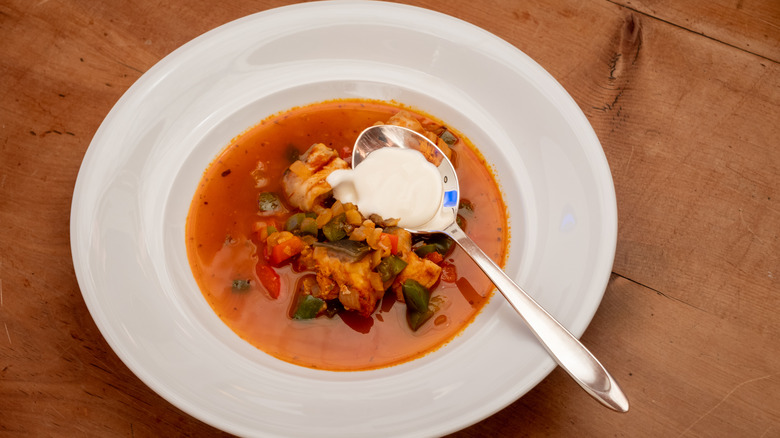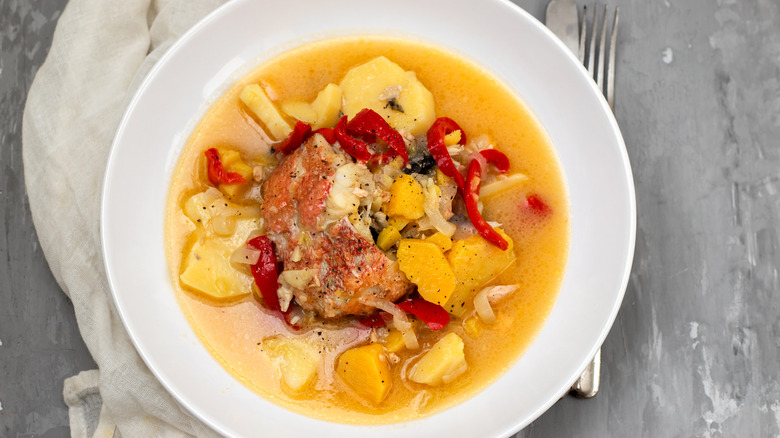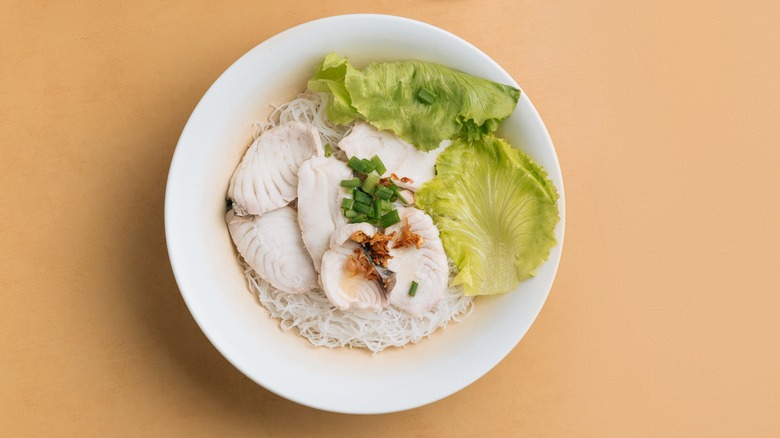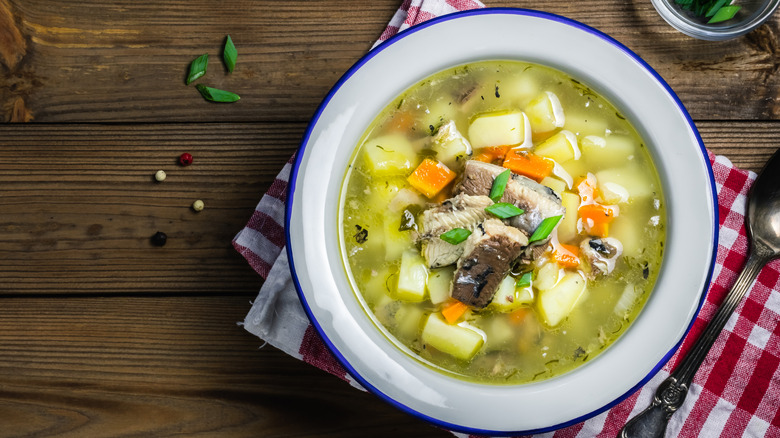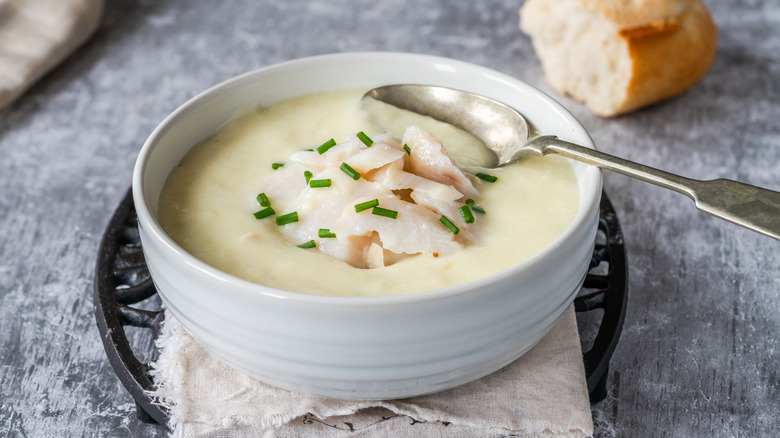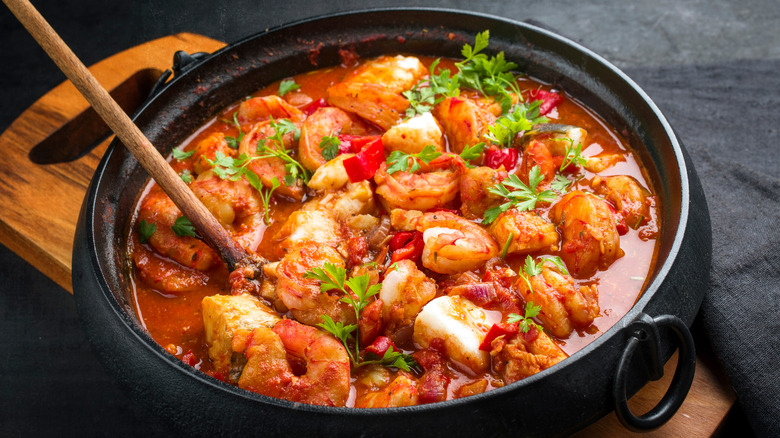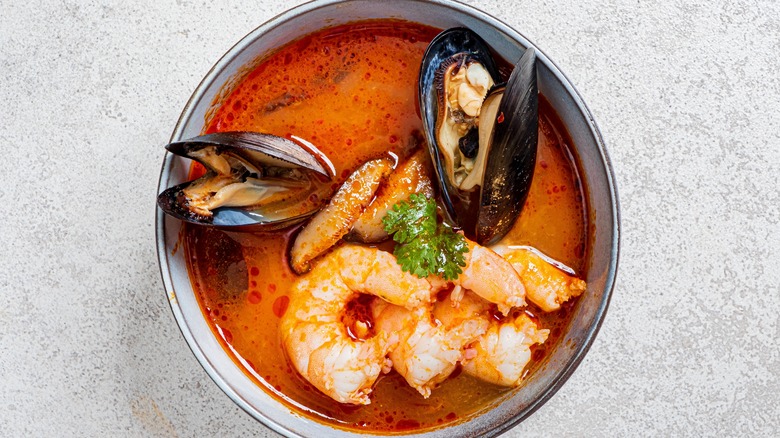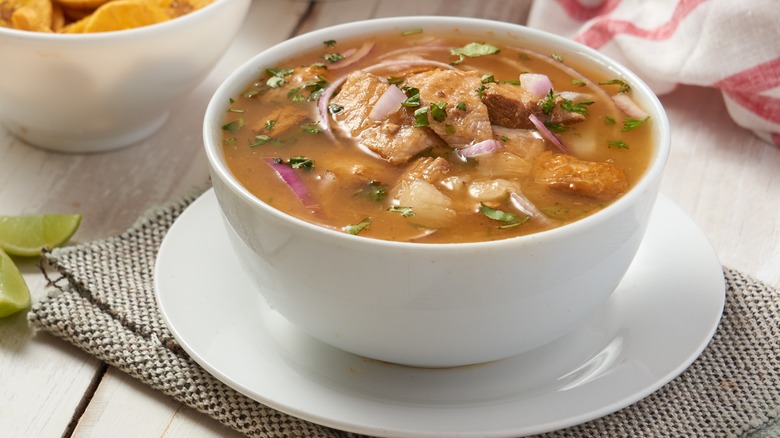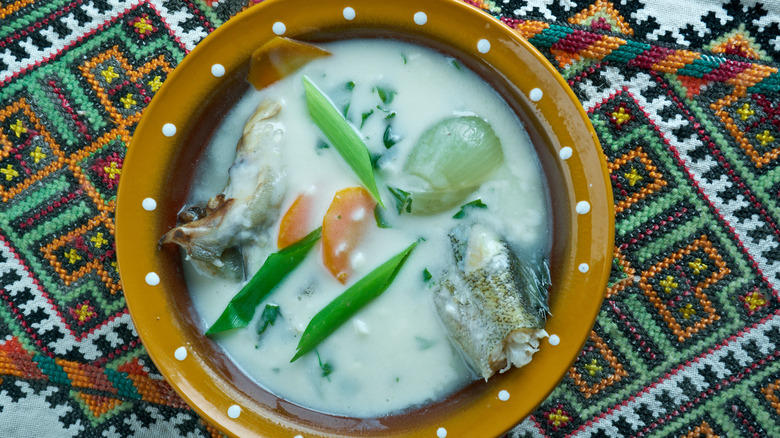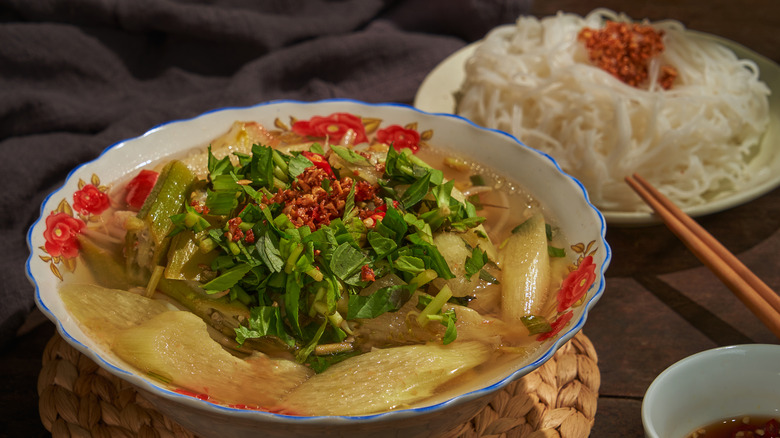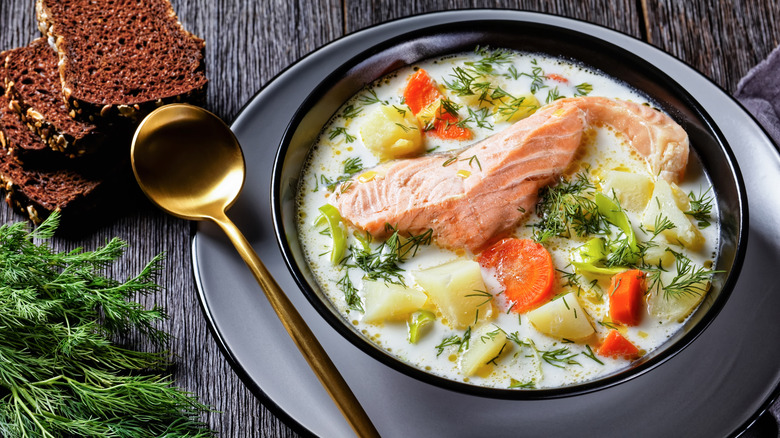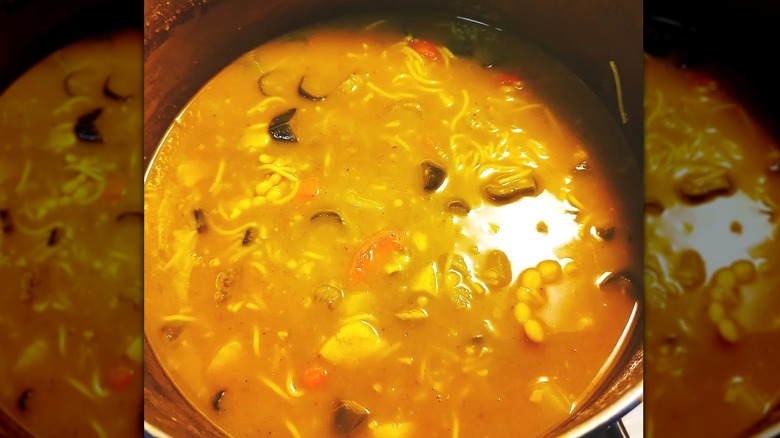20 Popular Fish Soups And Stews From Around The World
The ingredients, origins, and preparation methods may differ, but one thing is clear — fish soup is one of the most comforting and nourishing dishes on the planet, no matter where you eat it. From spicy Asian renditions like Thailand's tom yum talay and South Korea's maeuntang to creamy varieties like New England clam chowder and Finnish lohikeitto, there's no end to the way fish (and shellfish), vegetables, spices, and stock can be repurposed to create a delectable, heartwarming meal.
Join us as we dive into the deep end with these distinct fish soups and stews. Across continents, we'll introduce you to flavors that not only challenge conventional notions of what soup can be but also kindle a newfound appreciation for the diverse tapestry of global cuisine. Get ready to immerse yourself in the heart of these savory concoctions, where every bowl is a passport to a new and exciting gastronomic experience.
1. Tom yum talay
When the Thai soul craves comfort in a bowl, they turn to tom yum talay, a fiery elixir that rivals the soothing powers of chicken noodle soup. Unlike its Western counterpart, this Thai masterpiece embraces the briny depths of the sea, marrying a medley of seafood — from succulent shrimp to tender fish filets and briny clams — with the vibrant flavors of Thai chilies (prik kee noo), lemongrass, coconut milk, and lime.
Like any great Thai dish, tom yum talay is a complex, yet refreshing balance of salty, sweet, sour, and spicy notes. To truly elevate the culinary experience and create a complete meal in a bowl, pair it with fragrant jasmine rice or delicate rice vermicelli. Garnish with some fresh coriander leaves and sliced spring onions.
2. Clam chowder
This iconic American soup has three main contenders vying for the title of the ultimate chowder: Manhattan, New England, and Rhode Island. The New York version is instantly recognizable by its vibrant tomato-based broth, thin body, and slight acidity. On the opposite end of the spectrum, there's New England clam chowder, a veritable OG in the soup world. This timeless dish features a velvety cream-based broth, tender clams, potatoes, onions, and either bacon or salt pork.
And then there's the rebel of the trio — the Rhode Island version. While sharing common ingredients like bacon, onion, and celery with its counterparts, its broth is entirely different. Crafted from clam juice, it acts as more of a vessel to highlight the flavor of the fresh local clams than an ingredient unto itself.
3. Haraimi
Hailing from Libya, Haraimi is a spicy fish stew that combines puréed tomatoes, cod or halibut steaks, aromatics, and a spice blend featuring caraway powder, cumin powder, and paprika. The heat comes from the addition of jalapeños and cayenne pepper, two ingredients that make this dish particularly tantalizing in the winter. Lybians often serve the dish as an appetizer, but you can make it a main course by pairing it with bread, rice, or couscous.
Despite its current status as a household staple in Libya, Haraimi doesn't claim native roots. Instead, its origins harken back to the early 20th century, a period marked by Italian colonization in North Africa. The credit for this delectable creation goes to the Libyan Jews of that era, who introduced Haraimi as a classic Rosh Hashanah dish.
4. Mohinga
Mohinga, Myanmar's unofficial national dish and a quintessential breakfast food, is an aromatic soup that has served as a staple throughout the country's tumultuous history. Some claim that its origins date back to the first century, while others cite mentions of it in 18th-century poetry from the Alaungpaya Dynasty.
Regardless of its age, mohinga remains a sensory delight — a fragrant blend of fish broth, chickpea flour, lemongrass, turmeric, chili powder, catfish, shrimp paste, and fish sauce. The whole soup is served over a steaming bowl of vermicelli noodles. From there, it's garnished with lime, boiled eggs, cilantro, and chickpea fritters. In addition to the standard recipe, there are tons of regional variations. For example, coastal areas favor more seafood, whereas chefs in the northern Shan state infuse the broth with a fermented bean paste called pèhbal.
5. Psarosoupa
Dolmas and moussaka take center stage when it comes to Greek dishes you need to try, but don't overlook the humble psarosoupa. This unpretentious soup, whose name translates to "fish soup" in Greek, stars firm fish filets — think red mullet, snapper, cod, and red gurnard — alongside a vegetable ensemble featuring carrots, celery, onions, garlic, and potatoes.
But don't be fooled by the familiar ingredients, psarosoupa's preparation is anything but conventional. First, the vegetables are boiled. Once tender, they're removed from the broth. One half is mashed into the broth to give it body, while the other half is served as an accompaniment. Some variations incorporate an egg and lemon juice mixture called avgolemono to add extra body. From there, the fish is added to the vegetable mash and broth and cooked until tender.
6. Maeuntang
A mere glance at the ingredient list reveals the fiery essence behind the name of this Korean stew, aptly titled "spicy soup." Featuring the dynamic duo of gochujang, a red chili pepper paste, and gochugaru, also known as Korean red pepper flakes, the concoction promises a palate-tingling experience. Aside from the hot ingredients, you'll find an anchovy-based broth enriched with aromatics, tofu, radish, white fish, and an assortment of seafood.
Much akin to the communal spirit of Korean barbecue, maeuntang often graces tables in a shared pot, accompanied by an array of banchan including bean sprouts, spicy radish salad, and kimchi. But the culinary journey doesn't end there. Indeed, many eateries add rice to the leftover broth to create a soothing porridge sure to help you finish your feast in style.
7. Bourride
Originating in the Provençe region of France, bourride distinguishes itself from bouillabaisse by spotlighting affordable white fish instead of extravagant shellfish. Monkfish is the most traditional choice, but other firm varieties like halibut or sea bass also fit the bill. The broth is a blend of onion, fennel, celery, and garlic simmered in white wine and stock. Potatoes and fish are added towards the end of the cooking process.
Tasty as the base may be, aïoli is the true pièce de résistance. This silky emulsion of garlic, egg yolks, and olive oil is added at the end of the cooking process and gives bourride a velvety texture without the need for cream. Serve any extra aïoli with crusty bread alongside the bourride and you'll have a meal perfectly suited to the indulgent, yet laid-back Provençal region.
8. Caldillo de congrio
Caldillo de congrio is at the top of the list of Chilean dishes you need to try. Need more convincing? Pablo Neruda, widely regarded as Chile's greatest poet, penned an ode to this simple fish soup. At the core of this cold-weather dish is red conger, a local eel species. However, if that's unavailable, white fish serves as an acceptable substitute.
The eel takes its place in a vibrant red broth made from stewed tomatoes, onions, garlic, paprika, and wine. To further enrich the flavors, fish stock, parsley, and bay leaf are introduced before incorporating the eel or fish. Once the eel is cooked through, a generous pour of cream is added, accompanied by the essential seasoning of salt and pepper. Before serving, the dish is garnished with chopped cilantro and spicy salsa de ají.
9. Halászlé
As a landlocked country, Hungary's cuisine doesn't feature much in the way of seafood. However, the Central European nation compensates for the absence of maritime influences by showcasing dishes full of local fish from the Tisza or Danube rivers. These include species such as carp, perch, and pike.
You'll find some or all of these varieties in halászlé, a fisherman's stew made by simmering fish in a paprika-infused broth over an open fire, preferably outdoors. Alongside the paprika, expect to find wine and tomato paste in the recipe. Beyond that, good luck guessing. Hungarians are notably tight-lipped when it comes to their personal recipe. To make things even more complex, virtually every region boasts its unique variation of this dish, so you never know exactly what you're going to get.
10. Caldeirada
Similar to French bouillabaisse and Italian cacciucco, Calderira is a Portuguese and Galician fisherman's stew. As such, there's no set recipe. Rather, this dish revolves around the catch of the day. Expect to find everything from oily fish, like tuna or mackerel, to lean whitefish, such as cod or haddock. In addition, there's plenty of shellfish and squid.
In addition to the diverse array of seafood, caldeirada incorporates an array of vegetables like onions, potatoes, green peppers, and tomatoes. These ingredients are complemented by a blend of spices that includes bay leaf, coriander, paprika, and white pepper. Preparing caldeirada involves layering the vegetables in a large pot, strategically placing heartier ones like potatoes and onions closer to the flame, and leaving more delicate ones on top. Once the vegetables are tender, the fish and seafood are added.
11. Fish bee hoon
Although Singapore spans a mere 283.5 square miles, this city-state boasts a remarkable 110 hawker centers. These bustling open-air food markets are renowned for offering a diverse array of both local and international culinary delights. Given how heady the experience can be, you might be tempted to reach for familiar favorites, but we encourage you to try something new.
One standout recommendation is fish bee hoon soup. This dish revolves around two key elements: the rich fish stock and the delicate bee hoon noodles, also known as rice vermicelli. Hawkers make the fish stock by simmering fish heads with Chinese cooking wine, evaporated milk, and sesame oil. While that's cooking, the noodles are combined with fried snapper filets, blanched bok choy, and tomato wedges before getting doused with the fish stock and a sprinkling of spring onions.
12. Ukha
Ukha, a Russian fish soup, boasts a lengthy and intricate history. Its existence dates at least as far back as the 11th century, if not earlier. In its nascent stages, ukha was a broad term that described various soups made with wild game, poultry, or beef. It wasn't until the 17th century that ukha took on its exclusive identity as a fish soup. Understandably, the recipe continued to evolve throughout the centuries.
While regional and familial recipes differ to this day, the fundamental ukha recipe involves crafting a stock from fish bones, tails, and heads. These parts are simmered with onion, carrot, bay leaves, and peppercorns until fragrant. Into this transparent base go potatoes, celery, and chunks of fish like salmon, cod, or carp. A generous sprinkling of dill serves as the final touch.
13. Cullen skink
Along Scotland's North Sea coast, where chilly winds prevail, the need for warm, comforting dishes like Cullen skink is undeniable. Taking its name from Cullen, a village in Northern Scotland, and "skink," the Gaelic word for "essence," this fish soup epitomizes the region's hearty food culture.
At the core of Cullen skink are three indispensable ingredients: Aberdeenshire smoked haddock, potatoes, and cream. The haddock gives the soup a robust flavor, while the potatoes contribute body and creaminess. Preparing these simple ingredients is relatively straightforward. First, brown the onions in butter and cook the potatoes. Next, simmer the haddock in cream. Add the ingredients together, then dress with chives before serving. For extra flavor, try adding leeks, bay leaves, and pepper to the broth.
14. Cioppino
Cioppino is a hearty seafood stew with roots in San Francisco's vibrant Italian-American community. Bursting with a diverse medley of fresh white fish, clams, mussels, and shrimp, this dish pays homage to the oceanic treasures of San Francisco Bay. At the same time, it weaves in classic Italian ingredients like olive oil, wine, and parsley for an undeniable touch of Mediterranean flair.
But the true beauty of this soup lies in its adaptability. Because it relies on the catch of the day, every bowl of cioppino is as unique as it is fresh. While the seafood varies, the tomato-infused broth is a reliable backbone. You'll want to sop up every last drop, so we recommend serving cioppino with a slice (or two) of crusty bread.
15. Bouillabaisse
The earliest iterations of this fisherman's stew featured rockfish, a bony species that sometimes struggled to find its place in Marseille's restaurants and markets. Nowadays, bouillabaisse is more commonly prepared with the catch of the day, something that includes species like European conger, sea robins, and monkfish. The fish is served alongside generous portions of shellfish and seafood such as mussels, crabs, and octopus.
Complementing the array of fish and seafood is a medley of vegetables that includes leeks, onions, celery, and potatoes. These are seasoned with saffron, lemon juice, and orange zest as they simmer in the broth and bouillabaisse mixture. Adding to the uniqueness of this dish, bouillabaisse is traditionally served with toasted bread and rouille, a mayo-like condiment made with olive oil, saffron, and roasted red pepper.
16. Encebollado
Humble as it may be, Ecuador's encebollado is more than a simple fish soup. Rather, it's an embodiment of the South American country's coastal culinary identity. But it's not just a revered national dish, it's also a go-to hangover cure following a night of one too many aguardiente shots. That's why you'll also find it called chuchaqui, an Ecuadorian colloquialism meaning hangover. Given its centrality to Ecuadorian cuisine and culture, you'll find encebollado everywhere from street stalls to high-end restaurants.
This beloved fish soup features fresh albacore tuna, boiled yuca, tomatoes, onions, and cilantro. Once everything is cooked, the soup is garnished with pickled red onions. This seemingly simple addition is, in fact, what gives the soup its name, something that roughly translates to oniony fish soup.
17. Zupa rybna
Poland, renowned for its cold climate and dark winters, has earned a soup-centric reputation. While żurek, a sour soup crafted from fermented rye flour, often takes the spotlight, let's not overlook zupa rybna. Translating to fish soup, this culinary gem is a staple during traditional Christmas Eve celebrations. It features fish filets like sole, cod, or halibut simmered in vegetable broth.
Along with fish and broth, the standard recipe includes potatoes, aromatics, tomato, and a touch of milk or cream. Yet, as with many fish soups, all kinds of variations exist. Some opt for fried fish instead of boiled, while others introduce red peppers for an added pop of flavor. Regardless of the specific rendition, this delectable soup offers a perfect remedy for banishing the chill of winter evenings.
18. Canh chua
We're willing to bet that you've heard of phở, Vietnam's most famous soup export. But what about canh chua? Also known as Vietnamese sweet and sour soup, canh chua hails from the picturesque Mekong Delta region in Southern Vietnam. It features a pork and tamarind-infused broth that's generously adorned with catfish sourced from the delta's abundant waters. Complementing the fish are chunks of sweet pineapple, juicy tomatoes, elephant ear stalks, and crisp bean sprouts.
Traditionally, this comforting soup finds its perfect companion in a side of fragrant white rice. However, it's also a great match for cá kho tộ, a caramelized catfish dish. While the flavors are outstanding, what makes canh chua truly special is the fact that every family has its own unique rendition of this delectable fish soup.
19. Lohikeitto
Similar to lutefisk and Janssons frestelse, lohikeitto is a dish with roots in more than one Nordic country. As a result, you'll find it called by many names. In Finland, you'll hear it called lohikeitto, whereas the Swedes refer to it as laxsoppa. Whatever it's called, lohikeitto is essentially a creamy fish chowder made with salmon. There's plenty of fresh salmon in Scandinavia, but canned salmon serves as a convenient alternative in other parts of the world.
Besides salmon, cream, and fish broth, the basic recipe for lohikeitto calls for diced potatoes, leeks, carrots, allspice, and a healthy sprinkling of dill. Despite its seemingly sophisticated ingredients, lohikeitto is remarkably straightforward and unpretentious in its preparation. For the full Nordic experience, enjoy it with hearty pumpernickel or rye bread, both of which are perfect for soaking up the delightful flavors of this delicious soup.
20. Fish tea
Yes, you read that right. This Jamaican fish soup goes by the name tea. Despite the name, it's got nothing to do with leaves or herbs. Instead, it refers to the broth's consistency. Unlike other Jamaican soups like pepper pot and red pea, fish tea boasts a thin broth with minimal ingredients. This makes it a light and easy option for sipping, whether you're under the weather, celebrating a special occasion, or trying to beat the summer heat.
This delectable soup welcomes improvisation. Pair any fresh fish you have with yellow yam, pumpkin, okra, and carrot. And, of course, let's not overlook the scotch bonnet pepper. Ranging from 100,000 to 325,000 Scoville units, this chile pepper packs a punch not for the faint of heart. However, it's precisely what imparts fish tea with its distinctive Caribbean heat and flavor.
Static Media owns and operates Tasting Table and Mashed.
